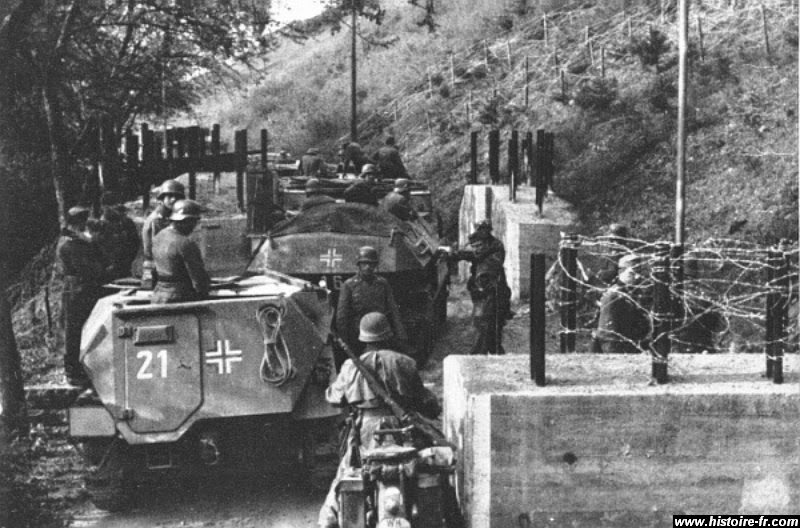Alankomaiden valtaus oli toisessa maailmansodassa osa Saksan armeijan operaatio Keltaista (saks. Fall Gelb), joka sisälsi hyökkäyksen Benelux-maihin ja Ranskaan.
Hyökkäys alkoi 10. toukokuuta 1940. Alankomaiden asevoimien pääosa antautui 14. toukokuuta, mutta pieni osa jatkoi taistelua Zeelandissa vielä 17. toukokuuta saakka.
Hyökkäyksessä maahanlaskujoukot valtasivat etenemiselle tärkeät maastonkohdat ennen maajoukkojen saapumista alueelle.
Saksan ilmavoimien tukemana maahanlaskujoukot valtasivat muun muassa lentokentät sekä keskeiset kaupungit, kuten Rotterdamin ja Haagin. Sotatoimet päättyivät pian Rotterdamin pommituksen jälkeen ja saksalaisten uhattua pommittaa muitakin kaupunkeja. Alankomaat pysyi saksalaisten miehittämänä vuoteen 1945.
Saksan hyökättyä Puolaan Britannia ja Ranska julistivat Saksalle sodan, mutta varsinaiset sotatoimet eivät länsirintamalla alkaneet. Talvi 1939–1940 tunnetaankin valesotana liittoutuneiden varustettua joukkojaan sotaan ja Saksan saatettua Puolan valtauksen päätökseen.
Adolf Hitler antoi 9. lokakuuta määräyksen Alankomaiden valtaamisesta ja vallatun maan käyttämisestä tukikohtana hyökättäessä Britteinsaarille. Suunnitelmaan sisältyi ehkäisevä hyökkäys Ruhrin aluetta uhanneita liittoutuneiden joukkoja vastaan.
Alankomaiden asevoimat olivat valmistautuneet vastarintaan heikosti.
Hitlerin noustua valtaan Alankomaat aloitti varustautumisen uudelleen mutta merkittävästi hitaammin kuin Ranska ja Belgia. Vasta vuonna 1936 Alankomaiden puolustusbudjettia alettiin kasvattaa merkittävästi. Alankomaiden hallitus kuitenkin vältti naapurimaansa provosoimista, eikä Saksa pitänyt Hollantia akuuttina uhkana. Osasyy tähän oli maiden välinen kauppa.
Adolf Hitler antoi 9. lokakuuta määräyksen Alankomaiden valtaamisesta ja vallatun maan käyttämisestä tukikohtana hyökättäessä Britteinsaarille. Suunnitelmaan sisältyi ehkäisevä hyökkäys Ruhrin aluetta uhanneita liittoutuneiden joukkoja vastaan.
------------------------------
After the German invasion of Poland in September 1939 and the ensuing outbreak of the Second World War, the Netherlands hoped to remain neutral, as they had done during the First World War 25 years earlier. To ensure this neutrality, the Dutch army was mobilised from 24 August and entrenched. Large sums (almost 900 million guilders) were spent on defence.
It proved very difficult to obtain new matériel in wartime, however, especially as the Dutch had ordered some of their new equipment from Germany, which deliberately delayed deliveries. Moreover, a considerable part of the funds were intended for the Dutch East Indies (now Indonesia), much of it related to a plan to build three battle cruisers.
The strategic position of the Low Countries, located between France and Germany on the uncovered flanks of their fortification lines, made the area a logical route for an offensive by either side. In a 20 January 1940 radio speech Winston Churchill tried to convince them not to wait for an inevitable German attack, but to join the Entente cordiale. Both the Belgians and Dutch refused, even though the German attack plans had fallen into Belgian hands after a German aircraft crash in January 1940 in what became known as the Mechelen Incident.
The French considered violating the neutrality of the Low Countries if they had not joined the Allies before the planned large Allied offensive in the summer of 1941.
Previously such a violation was indicated if Germany attacked the Netherlands, necessitating an Entente advance through Belgium, or if the Netherlands tolerated a German advance into Belgium through the southern part of their territory, both possibilities discussed as part of the hypothèse Hollande.
The Dutch government never officially formulated a policy on how to act in case of either contingency; the majority of ministers preferred to resist an attack, a minority and Queen Wilhelmina refused to become a German ally whatever the circumstances. The Dutch tried on several occasions to act as an intermediary to reach a negotiated peace settlement between the Entente and Germany.
After the German invasion of Norway and Denmark, followed by a warning by the new Japanese naval attaché Captain Tadashi Meada that a German attack on the Netherlands was certain, it became clear to the Dutch military that staying out of the conflict might prove impossible. They started to fully prepare for war, both mentally and physically.
Dutch border troops were put on greater alert. Reports of the presumed actions of a Fifth Column in Scandinavia caused widespread fears that the Netherlands too had been infiltrated by German agents assisted by traitors. Countermeasures were taken against a possible assault on airfields and ports. On 19 April a state of emergency was declared.
However, most civilians still cherished the illusion that their country might be spared, an attitude that after the war has been described as a state of denial.
The Dutch hoped that the restrained policy of the Entente and Central Powers during the First World War might be repeated and tried to avoid the attention of the Great Powers and a war in which they feared a loss of human life comparable to that of the previous conflict.
On 10 April Britain and France repeated their request that the Dutch enter the war on the side of the Allies, but were again refused...







Not easy for the 'Low Countries', another very interesting post sir!
VastaaPoistaHi, Phil
PoistaThank you for the compliment
There really was not easy.
Only one old Renault Ft tank and a handful of cannons.
A few of the Fokker plane, with ammunition ran out too soon...
Great images of a sad time - love the Fallshirmjaeger video!
VastaaPoistaHi, DeanM
PoistaIt was a sad time in every corner
:) the rattling bunch
I also like these elite troops, and this fallshirmjaeger helmet (short neck part) model is still present in many well-known context.
37 fallshirmjaeger junkers 52 planes, Dutch Fokker knocked down